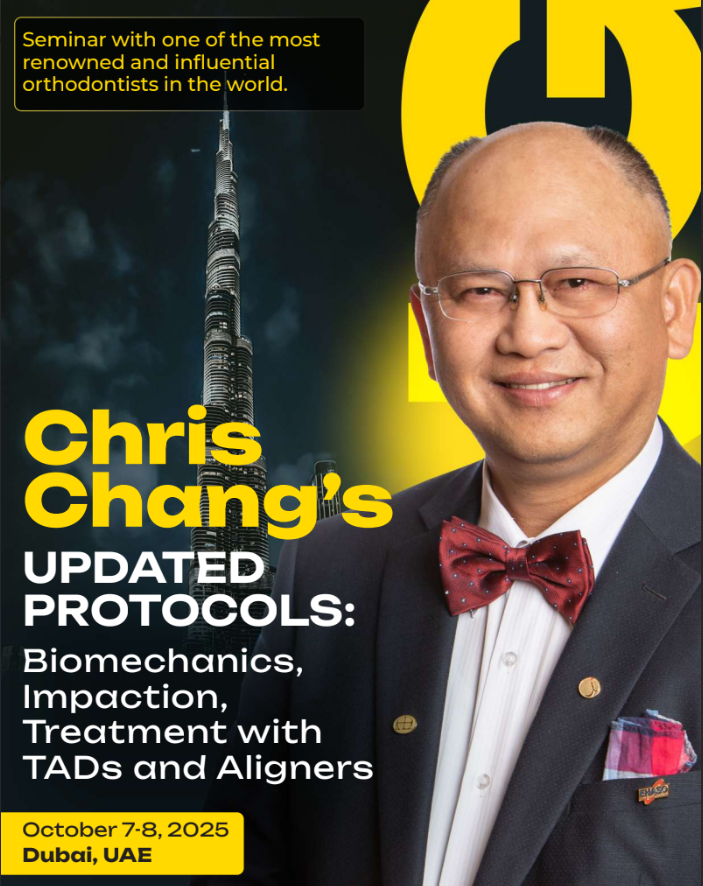Chris Chang Q&A
1. Clinical Philosophy & Treatment Decision-Making
Q: What are your criteria for choosing non-surgical approaches in Class II/III cases, or deciding between extraction and non-extraction?
A: The patient’s profile is the key. If the facial profile is acceptable and the patient prefers non-surgical treatment, I will give it a try. My philosophy is to provide the least invasive option possible, but I always explain the pros and cons clearly. In relapse cases, I even offer free re-treatment, because every failure is an opportunity for me to improve.
2. TADs (IZC, Buccal Shelf)
Q: What is your protocol for TAD placement and what kind of screws do you prefer?
A: For the upper arch, I usually place TADs in the infrazygomatic crest; for the lower arch, the buccal shelf is my favorite site. I always palpate for the thickest bone and stretch the mucosa during insertion to avoid soft tissue entanglement. I prefer stainless steel screws because they are stronger and more resistant to breakage, especially in dense mandibular bone. With proper method, my success rate is about 93–95%.
3. Speaking & Communication
Q: How did you become such a confident speaker, and what advice would you give to others?
A: For me, confidence comes from sharing, not showing off. When you genuinely want to share with your colleagues, speaking feels natural. Preparation and sincerity are essential, and watching TED talks is a great way to learn effective communication. I also strongly recommend joining a study club—it keeps you motivated, sharp, and continuously improving. That’s really a must for anyone who wants to become a great speaker.
4. Career Journey & Personal Philosophy
Q: How did your early life shape your career, and what is your ultimate goal?
A: I grew up in a poor village in Taiwan, barefoot until school age, and I learned problem-solving by teaching myself. Orthodontics was not my first choice, but a journal article and a professor’s encouragement changed my path. My philosophy is that dentistry is both art and science, and my ultimate goal is peace of mind—achieved by following a disciplined daily routine and enjoying the work I do.
5. Innovation & Technology
Q: Why do you still use Damon brackets, and how do you view digital dentistry?
A: My own extensive clinical experience convinces me that the combination of self-ligating brackets and extra-radicular TADs delivers results more efficiently. Evidence-based studies are valuable, but real-world orthodontics has too many variables that research can’t fully capture. Looking ahead, dentistry is changing very fast—digital technology IS already commonly utilized in clinics everywhere.
6. Speaking & Communication
Q: How did you become such a confident speaker, and what advice would you give to others?
A: For me, confidence comes from sharing, not showing off. When you genuinely want to share with your colleagues, speaking feels natural. Preparation and sincerity are essential, and watching TED talks is a great way to learn effective communication. I also strongly recommend joining a study club—it keeps you motivated, sharp, and continuously improving. That’s really a must for anyone who wants to become a great speaker.

Don't miss out on seeing the course of Chris Chang's Updated Protocols: Biomechanics, Impaction, Treatment with TADs and Aligners in person and learn modern orthodontics from one of its pioneers, held in the vibrant city of Dubai. During this 2-day event, you will not only gain valuable orthodontic knowledge but also be inspired by Chris Chang’s exceptional energy and passion for advancing the field.
We also invite you to watch the online-course TADs and aligners. Digital orthodontics. Early treatment. Face asymmetry to develop the knowledge about orthodontics.
